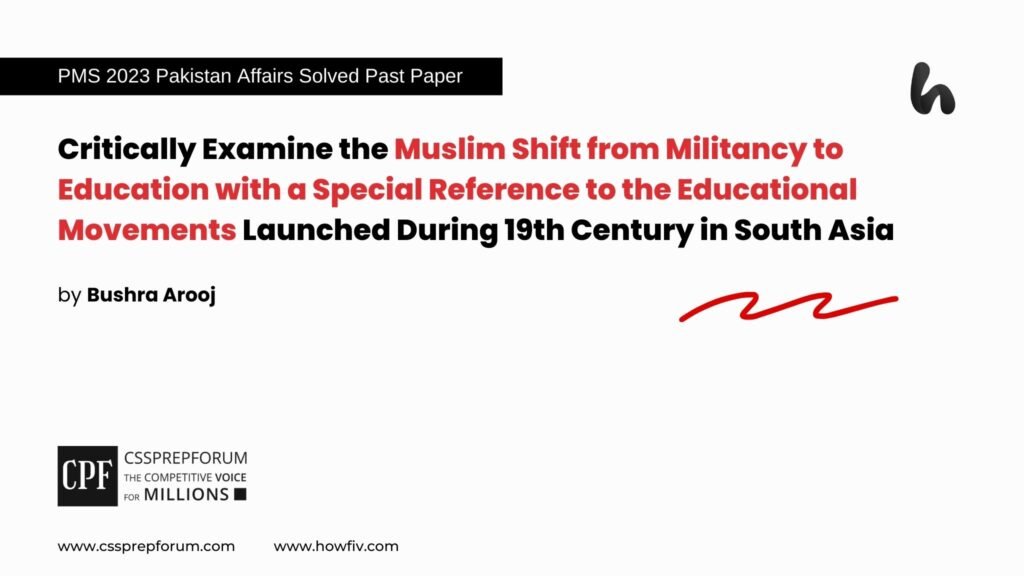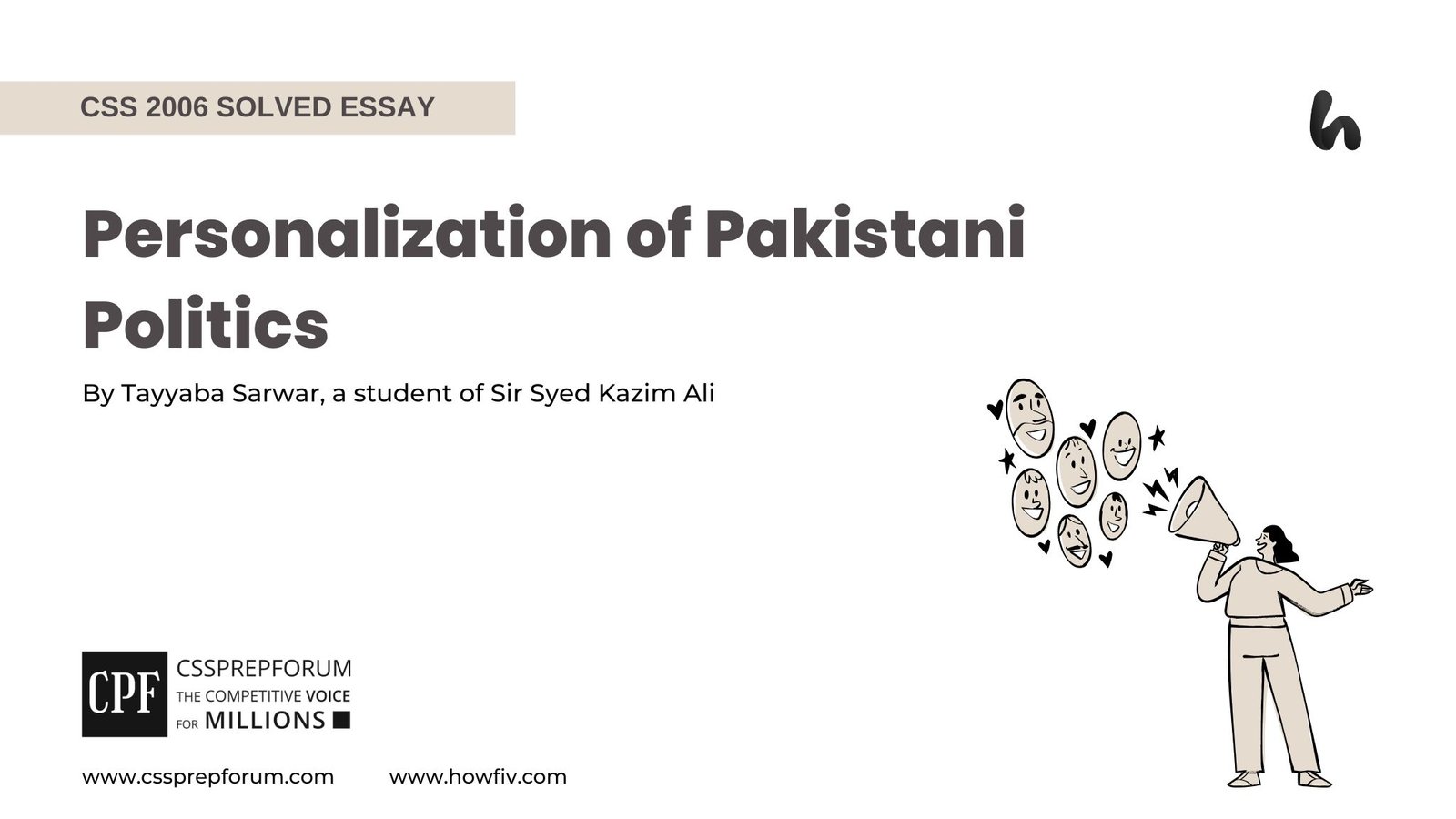PMS 2023 Solved Pakistan Studies Past Papers | Muslim Shift from Militancy to Education in the 19th Century
The following question of CSS Pakistan Studies 2023 is solved by Miss Bushra Arooj, the best Pakistan Affairs Coach, on the guided pattern of Sir Syed Kazim Ali, which he taught to his students, scoring the highest marks in compulsory subjects for years. This solved past paper question is uploaded to help aspirants understand how to crack a topic or question, how to write relevantly, what coherence is, and how to include and connect ideas, opinions, and suggestions to score the maximum.

Question Breakdown
In this question, the examiner has asked you to critically examine the shift of Muslims from militancy to education in South Asia. You must discuss reasons for the shift – What factors led Muslims to prioritize education over armed resistance, key educational movements – Highlight major 19th-century initiatives like the Aligarh Movement, Deoband, and Nadwat-ul-Ulama, and the impact of these movements – How did these reforms shape Muslim society and their future in British India?
Outline
1-Introduction
2-Historical Context of Muslim Militancy in South Asia
3-Factors leading to the shift from militancy to education
- ✓ Colonial Impacts in the lives of Muslims
- ✓ Economic Challenges Faced by Muslims
- ✓ Threat to Muslim Identity
4-Educational Movements launched during 19th century
- ✓ Aligarh Movement
- ✓ Deo-Band Movement
- ✓ Anjuman-i-Islamia
- ✓ Nadwatul-Ulama
- ✓ Islamia College Movement
- ✓ Bareilly Movement
5-Characteristics of Educational Movements
- ✓ Curricular Changes
- ✓ Institutional Development
- ✓ Community Engagement
6-Legacy of the Educational Movements
- ✓ Social Reforms and Activism
- ✓ Intellectual Awakening
- ✓ Muslim Empowerment
- ✓ Political Mobilization of Muslims
7-Conclusion

Answer to the Question
Introduction
In the late 19th century, the Indian Sub-continent witnessed intricate challenges in the historical context of colonial rule that altered the social fabric of South Asian societies. Particularly, these changes brought a dual threat to the lives of Muslims, who used to unsheathe swords for their survival. Despite grappling with the consequences of colonialism, Muslims faced erosion of their cultural identity and socioeconomic disparities, leading them to isolation. However, in no time, reformist emerged who recognized the need to awaken Muslims from their slumbers. In response to these existential challenges, various educational movements rose, aiming to empower Muslims through education. To illustrate, movements, such as the Aligarh Movement and the Deoband Movement sought to redefine Muslim identity while struggling to promote modern education and social reform. These initiatives proved to be fruitful in fostering self-awareness and resilience against both colonial oppression and socio-economic marginalisation. Moreover, the subsequent features of these movements—from curricular innovations to community engagement—played a crucial role in shaping a new Muslim consciousness that prioritized education as a means of empowerment. Thus, the transformative legacy not only resulted in social reforms and intellectual awakening but also laid the groundwork for political mobilization among Muslims in South Asia. Therefore, the narrative of the shift from militancy to educational movements is intricately linked to the broader context of educational endeavours that sought to uplift a community facing unprecedented challenges.
Historical Context of Muslim Militancy in South Asia
In the context of history, after the decline of the Mughal Empire, the arrival of the British Empire in the 18th century led to significant political upheaval, economic disruption, and social dislocation among Muslim communities as the subsequent British colonial policies marginalized Muslims, fostering feelings of disenfranchisement and alienation. However, this period also witnessed the rise of various militant movements as segments of the Muslim population reacted to perceived threats to their identity, culture, and religious practices. Notably, the struggle for independence from colonial rule often manifested in both peaceful and violent forms, with some sections advocating for armed resistance. Therefore, this historical backdrop laid the groundwork for ongoing militancy in the region as socioeconomic inequities and political grievances continued to fuel radical ideologies. However, the legacy of militancy also provoked a significant shift towards education and social reform among Muslims, as leaders sought to address the root causes of disparities through intellectual and educational empowerment.
Factors leading to the shift from militancy to education
Before understanding the educational movements, it is paramount to understand the factors that forced Muslim scholars to resort to educational initiatives instead of showing armed resistance to British colonial rule.
- Colonial Impacts in the Lives of Muslims
In the pre-colonial era, Muslim education was primarily centred around Islamic teachings and the Madrassa system. However, the advent of colonialism, particularly under British and French rule, disrupted this Muslim education system. The introduction of Western education led to a reluctance among Muslims to embrace modern, non-Islamic educational systems, contributing to their socio-economic decline. This neglect of Islamic education, coupled with the inequitable educational policies imposed by colonial powers, hindered Muslims from adhering to their principles and values. Moreover, Colonial administrations often used education as a tool to consolidate power, creating dual systems where Western-style education offered access to status and employment, while traditional Islamic institutions were marginalized. As a result, Muslim intellectuals initiated educational movements to address these challenges and revive their cultural and religious identity.
- Economic Challenges Faced by Muslims
Moreover, economic challenges faced by Muslims during colonial rule were significant factors leading Muslim Intellects to resort to education. During the 19th century, Muslim merchants lost significant ground to European traders and local non-Muslim minorities, who well benefitted from the colonial policies. Besides, the rise of Western economic institutions rendered the Islamic commercial system and made traditional Islamic methods less competitive. As a result, owing to the colonial policies, the economic system in Bengal was disrupted and led to poverty and inequality in Muslim societies. Therefore, all these challenges awaken Muslims to shift towards education from militancy.
- Threat to Muslim Identity
Above all, the colonial rule in India during the 19th century posed a serious threat to Muslim Identity, forcing Muslims to shift from militancy to education. To elaborate, the challenges, including erosion of Muslims’ cultural and religious identity, marginalization of traditional Islamic practices, and emphasis on secular education and practices, were perceived as vehicles threatening the spiritual and moral fabric of Muslim societies. Therefore, the shift from militancy to education was, in fact, a strategic response to the existential threats to Muslim identity imposed by colonial rule.
Educational Movements launched during the 19th century
Delving down the ladder, the following paragraphs discuss the educational movements led by different communities having different thoughts. Although there was a division among them, each played a significant role in empowering Muslims.
- Aligarh Movement
To begin, the Aligarh movement, a response to colonial policies and an initiative to revitalize the Muslim Community, was launched during the second half of the 19th century under the leadership of Sir Sayed Ahmed Khan. In the aftermath of the 1857 Indian Rebellion and colonial rule, Sir Sayed Ahmed Khan sought to modernize Muslim Society by integrating modern scientific knowledge with Islamic teachings. He aimed at fostering the socio-economic progress of Muslims and improving their relation with British rule for the sake of pursuing scholastic advancement with a renewed sense of Muslim Identity. To pursue his goal, Sir Sayed Ahmed Khan established Persian Madrassa in Moradabad in 1859, built Scientific Society in Ghazipur in 1864, and significantly founded Anglo-Oriental College at Aligarh in 1875, which later proved to be a cornerstone of Muslim renaissance in South Asia. To conclude, the establishment of the Persian Madrassa, Scientific Society, and Anglo-Oriental College at Aligarh was among the most prominent efforts of Sir Sayed Ali Khan in the form of an educational movement.
- Deo-Band Movement
Moreover, The Deoband Movement launched in 1866 with the establishment of the Darul Uloom -an Islamic academic centre in Uttar Pradesh- proved to be a significant educational initiative aimed at preserving and promoting Islamic identity under British colonial rule. Under the leadership of Muhammad Qasim Nanautawi and Rashid Ahmad Gangohi, the movement was a huge response to the socio-political cataclysm following the 1857 Indian Rebellion, which was responsible for the severe repression of Muslims. Accordingly, the Movement sought to revive Islamic teachings and moral values through traditional religious education. The madrasa at Deoband became a model institution, offering structured curricula and relying on grassroots financial support. It also opposed British influence and Hindu revivalist organizations like Arya Samaj and promoted a purified form of Islam free from superstitions and un-Islamic practices. It also advocated composite nationalism, aligning with the Indian National Congress to resist British rule. To conclude, the Movement remained as a cornerstone of Islamic revivalism, emphasizing moral integrity, religious knowledge, and resistance to colonial cultural domination.
- Anjuman-i-Islamia
Additionally, established in the mid-19th century, the Anjuman-i-Islamia held great significance as an educational movement that aimed at addressing socio-economic and political challenges faced by Muslims due to colonial rule. Moreover, the primary objectives of the movement were to unite Muslims, promote Islamic education, foster cooperation with the British government, ensure community welfare, and avoid rebellion. In this regard, it has emphasized modern education alongside Islamic teachings, opposed anti-British movements like the Sepoy Revolt, and discouraged any uprising against the British government. Therefore, by normalizing with the government, Anjuman-i-Islamia succeeded in countering the decline in Muslim socio-economic influence.
- Nadwatul-Ulama
Next, founded by Maulvi Abdul Ghafur and initially managed by Muhammad Ali Mungeri, the Nadwatul-Ulema Movement, established in 1893, was a prominent educational movement that aimed at bridging the gap between traditional Islamic education and modern Western Learning. Moreover, unlike the Aligarh Movement, which focused on Western education, and the Deoband Movement, which emphasized Islamic education only, the Nadwatul Ulema Movement preferred to be moderate and made efforts to remove sectarianism among Muslims, eliminate extremist educational ideas, improve curriculum, and address social issues. Later, the Nadwatul–Ulama Movement gained significant support from Muslim scholars and received patronage from the British Government. To conclude, the Nadwatul – Ulama well recognized the needs of the then Muslims and played a significant role in addressing challenges faced by Muslims under the colonial rule of the British government.
- Islamiyah College Movement
Apart from that, the Islamiya College Movement, established in the late 19th century, emerged as a beacon of knowledge for the Muslim community. Moreover, combining elements of the Aligarh Movement and Deoband School of thought, the objectives of Islamiya College were to provide education to Muslims, preserve Islamic values, and foster leadership in the community. Moreover, it also emphasized the integration of Western scientific education with Islamic principles, aiming to address the challenges Muslims faced under colonial rule. Also, owning to its struggle for better education, the movement gained excellence and cultural preservation, contributing to the intellectual and political awakening of Muslims in British India. To conclude, the Islamiya College Movement is among the significant movements that were launched to promote quality education, not militancy, among Muslims.
- Bareilly Movement
Last but not least, during the time of colonial upheaval, the Bareilly Movement- also known as the Barelvi Movement- emerged as a candle of hope for Muslims under the oppressive government of the British. Like other movements, the ambition of the Barelvi movement was also to enlighten Muslims with the glory of knowledge. The movement aimed at defending traditional Islamic practices, promoting Islamic education, and preserving the spiritual and cultural heritage of South Asian Muslims. In this regard, it emphasized devotion to the Prophet Muhammad (s.w), adherence to the Hanafi school of thought, and commitment to antirecessionary practices associated with Sufism. Moreover, educational initiatives, such as the establishment of Madrassa in cities like Pilibhit and Lahore, became centres for disseminating its teachings. To conclude, while fostering a sense of identity among Muslims in colonial India, the Barelvi movement largely emphasized education and spiritual renewal, helping preserve Islamic traditions.
Characteristics of Educational Movements
Notably, the educational movements launched during the 19th century possess significant features that brought fruitful and lasting results in the lives of Muslims. These features are mentioned below.
- Curricular Changes
First, the educational movements aimed at providing curricula that reflect a global trend toward balancing traditional values with contemporary needs. For this purpose, curricula expanded beyond classical studies and included subjects such as history, geography, modern languages and sciences. Taking the curricula of the Aligarh movement as an example, the English language had also become a compulsory subject alongside Islamic studies to integrate Muslims into the administrative and economic system. Moreover, the Aligarh interpreted different scientific books into Persian and Arabic languages to enlighten Muslims with modern education. Controversly, some movements, such as the Deoband Movement, had highly focused on Islamic teaching practices in their curriculum. To conclude, the curriculum changes were designed in a way that aligns with modern education and the English language alongside Islamic teachings.
- Institutional Development
Next, institutional development was the cornerstone of educational movements launched during the 19th century. These institutions played a pivotal role in reshaping the fate of Muslims in British India, returning back the dignity and power of Muslims. In this regard, the Aligarh Movement established Muhammadan Anglo-Oriental College in 1875, which later became Aligarh Muslim University. This college had given birth to Muslim Intellects who advocated the creation of Pakistan. Similarly, the Deoband Movement Movement founded the Darul Uloom Deoband in 1866, and the Nadwatul-Ulama movement established Darul Uloom Nadwatul Ulama in 1898 not only provided education but also became the centre of cultural and intellectual revival. To conclude, developing institutes were among the most prominent features of educational development, which advocated the rights of Muslims for decades.
- Community Engagement
Lastly, as movements sought to involve local populations in the pursuit of intellectual and social progress, community engagement became a defining characteristic of the educational movements launched during the 19th century. To elaborate, Movements like the Aligarh Movement, led by Sir Syed Ahmad Khan, actively engaged Muslim communities through public lectures, publications, and the establishment of institutions such as the Muhammadan Anglo-Oriental College. Also, annual educational conferences were organized to gather support for modern education and foster unity among Muslims across India. Similarly, the Deoand and other educational movements largely facilitated conferences and meetings to unite Muslims. In a nutshell, community engagement via different sources is defined as the foremost feature of Educational movements led by Muslim reformers.
Legacy of the Educational Movements
Owning to the limitless endeavours of Muslim intellects, the Muslim societies in the Indian sub-continent once more became powerful enough to decide their own fate. The following paragraphs shed light on the lasting legacy of the educational movements.
- Social Reforms and Activism
To start, although the educational movements were criticised for dividing the Muslim community into two groups known as pro-Anglicists- Pro Western (English Learning Muslim modernist) on one side and anti-Western (traditional learning Muslims) on the other side, it is worth considering that the educational movements led by Muslim scholars undoubtedly left a lasting legacy of social reforms and activism, ensuring socio-economic and political rights of Muslims. For instance, the Aligarh movement led by Sir Sayed Ahmed Khan had successfully reconciled Islamic values with Western knowledge, fostered a renaissance within the Muslim community, influenced Urdu literature and used it to convey the movement’s purpose, and later brought Muslims under one umbrella Aligarh Movement, which years later paved the path for the creation of Pakistan. To conclude, the shift from militancy to educational movements proved to be a turning point for re-empowering Muslims and contributing to social reforms and activism.
- Intellectual Awakening
Moreover, notwithstanding the community division known as pro-Anglicists brought challenges within Muslims community, however, with the passage of time the community division had led to the emergence of Muslims intellectuals who addressed such challenges and shaped a united society. For instance, both the movements, the Aligarh and the Deoband movements, played their specific roles in developing the Muslim community, with the former imparting modern education while the latter preserving the religious and cultural identity of Muslims. Thus, the intellectual awakening in the form Aligarh Movements and Deoband movements along with other particular movements played pivotal role in shaping the destiny of Muslims in Indian Sub-continent.
- Muslim Empowerment
Undoubtedly, the educational movements laid the groundwork for Muslim empowerment. In the aftermath of the decline of the Mughal Empire, the Muslims faced adverse challenges due to which the Muslim intellectuals and scholars felt the need for an urgent shift from militancy to educational reforms for the sake of socio-economic reinforcement of Muslims. For this purpose, educational movements, such as the Aligarh movement and the Deoband movement, began to incorporate modern subjects alongside traditional Islamic teachings, promoting a more holistic approach to education. As a result, the movements led to the rise of other literary and cultural movements that brightened Muslim identity and pride, empowering Muslims socially, economically, and politically. To conclude, these educational advancements played a crucial role in empowering Muslims, enabling them to engage more effectively in the socio-political landscape of British India and paving the way for future movements advocating for their rights and representation.
- Political Mobilization of Muslims
Finally, the educational movements also marked the political mobilization of Muslims, aiming to revive and reform Islamic thought in response to colonial rule. To elaborate, as a result of the various educational movements, reformist thinkers emerged who advocated the political, cultural, social, and economic rights of Muslims to a large extent. For instance, the educational movements laid the groundwork for political mobilization, leading to the establishment of organizations like the All-India Muslim League in the 20th century. Therefore, it was the limitless efforts of reformists who formed educational movements which later shaped the political consciousness among Muslims, leading to the creation of Pakistan.
Conclusion
In conclusion, the shift from militancy to education among Muslims in South Asia during the 19th century was profoundly influenced by historical, social, and economic factors. The colonial legacy, along with economic challenges and threats to Muslim identity, framed a robust response in the form of various educational movements, particularly the Aligarh and Deoband movements. Moreover, these initiatives not only redefined the educational landscape but also fostered a sense of community engagement and social responsibility. The features of these movements, including curricular innovations and institutional development, laid the groundwork for intellectual awakening and Muslim empowerment. Ultimately, the legacy of these educational efforts reflected significant social reforms and political mobilization. In a nutshell, the article veered around significant educational movements that formed the destiny of Muslims under the British Empire.
CSS Solved Past Papers’ Essays
Looking for the last ten years of CSS and PMS Solved Essays and want to know how Sir Kazim’s students write and score the highest marks in the essays’ papers? Then, click on the CSS Solved Essays to start reading them.
CSS Solved Essays
CSS Solved General Science & Ability Past Papers
Want to read the last ten years’ General Science & Ability Solved Past Papers to learn how to attempt them and to score high? Let’s click on the link below to read them all freely. All past papers have been solved by Pakistan’s top CSS GSA coach having the highest score of their students.
General Science & Ability Solved Past Papers












